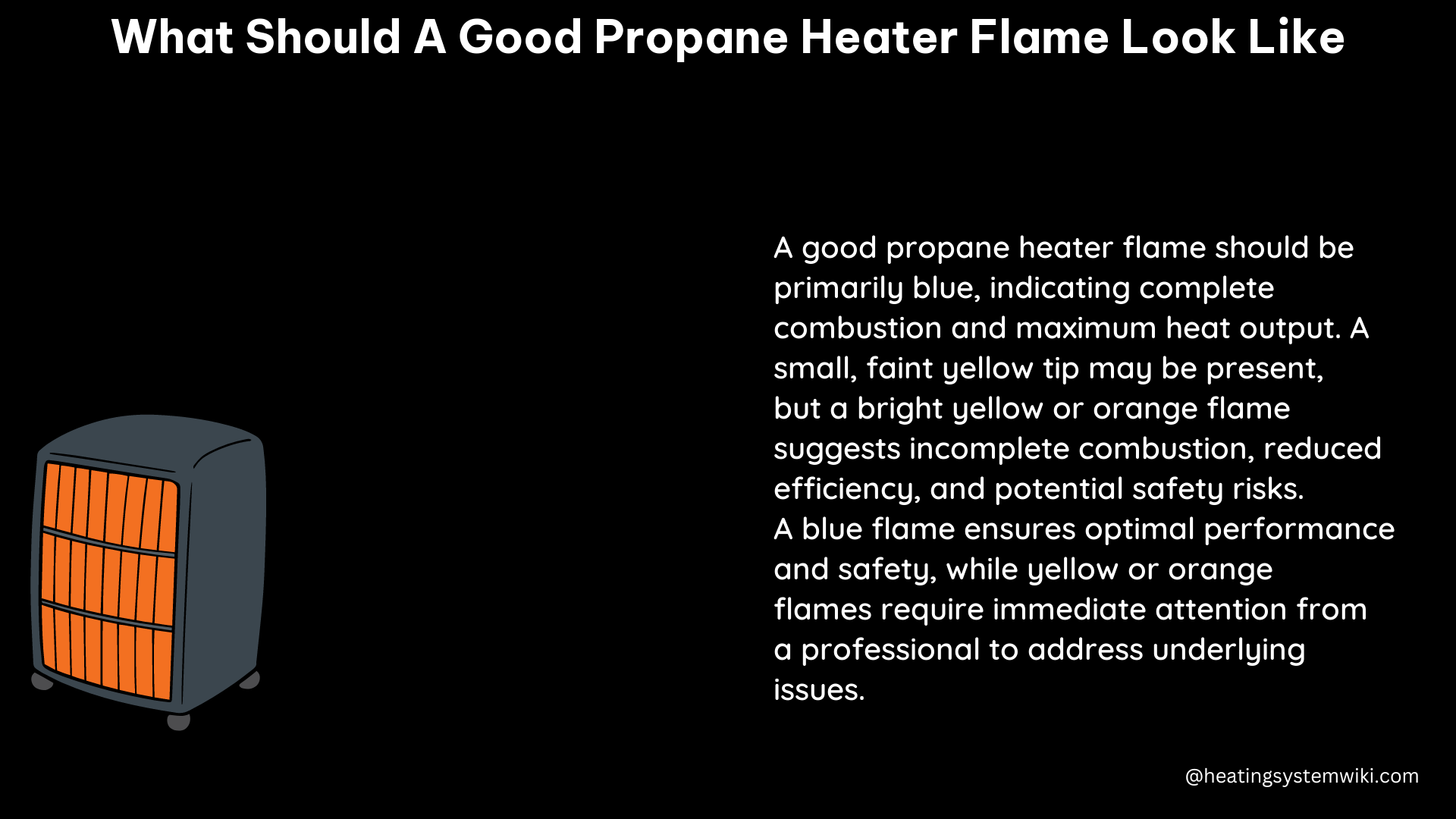A well-functioning propane heater should have a vibrant blue flame with a lighter shade bursting through the center, indicating efficient combustion and clean gas supply. Understanding the characteristics of a good propane heater flame is crucial for ensuring optimal performance, energy efficiency, and safety. In this comprehensive guide, we’ll delve into the technical specifications, troubleshooting tips, and best practices for maintaining a healthy propane heater flame.
Flame Color and Composition
The color of a propane heater flame is a direct reflection of the combustion process. Ideally, the flame should be a vivid blue hue with a lighter, almost white, center. This color combination signifies that the propane gas is burning efficiently, with little to no waste or contaminants.
| Flame Color | Indication |
|---|---|
| Vibrant Blue with Lighter Center | Efficient combustion, clean gas supply |
| Predominantly Blue with Yellow Specks | Acceptable, some incomplete combustion |
| Bright Red or Orange | Inefficient combustion, gas waste, harmful compounds |
| Green | Accumulated grime and soot, incomplete combustion |
| Yellow | Inadequate fuel combustion, potential carbon monoxide risk |
The blue color of the flame is a result of the complete combustion of the propane gas, where the carbon and hydrogen molecules in the fuel react with oxygen to produce carbon dioxide and water vapor. The lighter, almost white, center of the flame indicates that the combustion process is occurring at the optimal temperature, ensuring maximum heat output.
Factors Affecting Flame Appearance

Several factors can influence the appearance of a propane heater flame, including the gas supply quality, furnace maintenance, and air-fuel ratio adjustments.
Gas Supply Quality
The quality of the propane gas supplied to the heater can significantly impact the flame’s appearance. Contaminants or impurities in the gas can lead to incomplete combustion, resulting in a flame that appears yellow, orange, or even green.
To ensure a clean gas supply, it’s essential to use propane gas that meets industry standards. The American Society for Testing and Materials (ASTM) specifies the acceptable levels of impurities in propane gas, such as sulfur, water, and particulates. Regularly inspecting the gas supply line and filter can also help maintain the quality of the fuel.
Furnace Maintenance
Proper maintenance of the propane heater’s internal components is crucial for maintaining a healthy flame. Over time, the buildup of soot, dust, and other debris can interfere with the combustion process, leading to changes in the flame’s appearance.
Regular cleaning of the burners, heat exchanger, and other critical components can help restore the flame’s vibrant blue color and efficient combustion. It’s recommended to have a professional HVAC technician perform a comprehensive inspection and cleaning of the furnace at least once a year.
Air-Fuel Ratio Adjustments
The balance between the amount of air and fuel supplied to the burner can also affect the flame’s appearance. If the air-fuel ratio is not properly adjusted, it can result in incomplete combustion and changes in the flame color.
Adjusting the air-fuel ratio typically involves fine-tuning the gas pressure and secondary air supply. This process requires the use of a combustion analyzer and should be performed by a qualified HVAC technician to ensure the proper air-fuel mixture and safe operation of the propane heater.
Troubleshooting and Maintenance
To maintain a healthy propane heater flame, it’s essential to regularly inspect and perform routine maintenance on the system. Here are some key steps to ensure optimal flame performance:
-
Visual Inspection: Regularly check the flame’s appearance, looking for any changes in color, shape, or intensity. If you notice any significant deviations from the ideal blue flame with a lighter center, it may indicate an underlying issue that requires further investigation.
-
Cleaning and Maintenance: Ensure that the burners, heat exchanger, and other internal components are clean and free of debris. Use a soft-bristle brush or vacuum to remove any accumulated dust or soot, and follow the manufacturer’s instructions for proper cleaning procedures.
-
Air-Fuel Ratio Adjustment: If the flame appears to be burning unevenly or has a yellow or orange tint, it may be necessary to adjust the air-fuel ratio. This should be done by a qualified HVAC technician using a combustion analyzer to ensure the proper mixture and safe operation.
-
Carbon Monoxide Detection: Install a carbon monoxide (CO) detector in your home to monitor for the presence of this toxic gas. Incomplete combustion can lead to the production of CO, which can be hazardous to your health. If the detector senses elevated CO levels, it’s crucial to shut off the propane heater and have it inspected by a professional.
-
Manufacturer Recommendations: Consult the manufacturer’s instructions for your specific propane heater model. They may provide detailed guidance on the expected flame appearance, maintenance procedures, and troubleshooting steps to ensure optimal performance and safety.
By following these best practices and regularly maintaining your propane heater, you can ensure that the flame remains vibrant, efficient, and safe, providing reliable heating for your home.
Conclusion
Understanding the characteristics of a good propane heater flame is essential for maintaining the efficiency, safety, and longevity of your heating system. By familiarizing yourself with the ideal flame color, composition, and factors that can affect its appearance, you can proactively address any issues and ensure your propane heater is operating at its best.
Remember, regular maintenance, cleaning, and professional adjustments are crucial for keeping your propane heater running smoothly and safely. With this comprehensive guide, you’ll be well-equipped to monitor and maintain a healthy propane heater flame, ensuring your home stays warm and comfortable throughout the colder months.
